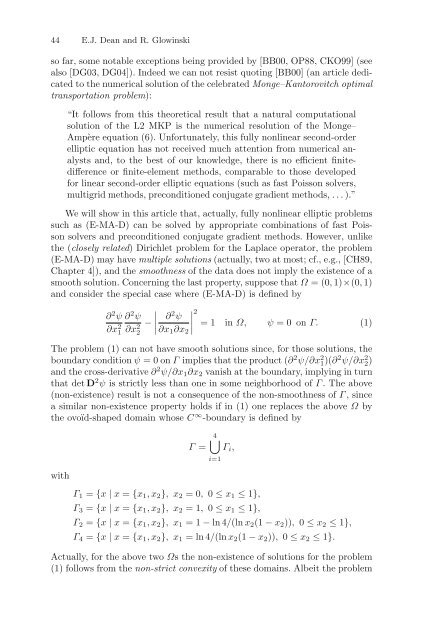Partial Differential Equations - Modelling and ... - ResearchGate
Partial Differential Equations - Modelling and ... - ResearchGate
Partial Differential Equations - Modelling and ... - ResearchGate
You also want an ePaper? Increase the reach of your titles
YUMPU automatically turns print PDFs into web optimized ePapers that Google loves.
44 E.J. Dean <strong>and</strong> R. Glowinski<br />
so far, some notable exceptions being provided by [BB00, OP88, CKO99] (see<br />
also [DG03, DG04]). Indeed we can not resist quoting [BB00] (an article dedicated<br />
to the numerical solution of the celebrated Monge–Kantorovitch optimal<br />
transportation problem):<br />
“It follows from this theoretical result that a natural computational<br />
solution of the L2 MKP is the numerical resolution of the Monge–<br />
Ampère equation (6). Unfortunately, this fully nonlinear second-order<br />
elliptic equation has not received much attention from numerical analysts<br />
<strong>and</strong>, to the best of our knowledge, there is no efficient finitedifference<br />
or finite-element methods, comparable to those developed<br />
for linear second-order elliptic equations (such as fast Poisson solvers,<br />
multigrid methods, preconditioned conjugate gradient methods, ...).”<br />
We will show in this article that, actually, fully nonlinear elliptic problems<br />
such as (E-MA-D) can be solved by appropriate combinations of fast Poisson<br />
solvers <strong>and</strong> preconditioned conjugate gradient methods. However, unlike<br />
the (closely related) Dirichlet problem for the Laplace operator, the problem<br />
(E-MA-D) may have multiple solutions (actually, two at most; cf., e.g., [CH89,<br />
Chapter 4]), <strong>and</strong> the smoothness of the data does not imply the existence of a<br />
smooth solution. Concerning the last property, suppose that Ω =(0, 1)×(0, 1)<br />
<strong>and</strong> consider the special case where (E-MA-D) is defined by<br />
∣<br />
∂ 2 ψ ∂ 2 ψ<br />
∂x 2 1 ∂x 2 −<br />
∂ 2 ψ ∣∣∣<br />
2<br />
∣ =1 inΩ, ψ =0 onΓ. (1)<br />
2 ∂x 1 ∂x 2<br />
The problem (1) can not have smooth solutions since, for those solutions, the<br />
boundary condition ψ =0onΓ implies that the product (∂ 2 ψ/∂x 2 1)(∂ 2 ψ/∂x 2 2)<br />
<strong>and</strong> the cross-derivative ∂ 2 ψ/∂x 1 ∂x 2 vanish at the boundary, implying in turn<br />
that det D 2 ψ is strictly less than one in some neighborhood of Γ .Theabove<br />
(non-existence) result is not a consequence of the non-smoothness of Γ , since<br />
a similar non-existence property holds if in (1) one replaces the above Ω by<br />
the ovoïd-shaped domain whose C ∞ -boundary is defined by<br />
with<br />
Γ =<br />
4⋃<br />
Γ i ,<br />
i=1<br />
Γ 1 = {x | x = {x 1 ,x 2 }, x 2 =0, 0 ≤ x 1 ≤ 1},<br />
Γ 3 = {x | x = {x 1 ,x 2 }, x 2 =1, 0 ≤ x 1 ≤ 1},<br />
Γ 2 = {x | x = {x 1 ,x 2 }, x 1 =1− ln 4/(ln x 2 (1 − x 2 )), 0 ≤ x 2 ≤ 1},<br />
Γ 4 = {x | x = {x 1 ,x 2 }, x 1 =ln4/(ln x 2 (1 − x 2 )), 0 ≤ x 2 ≤ 1}.<br />
Actually, for the above two Ωs the non-existence of solutions for the problem<br />
(1) follows from the non-strict convexity of these domains. Albeit the problem
















